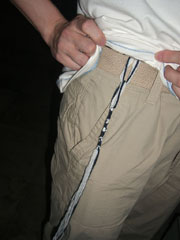“G-d spoke to Moses, telling him to speak to the Israelites and have them make tzitzit on the corners of their garments for all generations. They should include a twist of sky-blue wool in the corner tzitzit. These shall be your tzitzit, and when you see them, you shall remember all of G-d’s commandments so as to keep them. You will then not stray after your heart and eyes, which [in the past] have led you to immorality. You will thus remember and keep all my commandments, and be holy to your G-d. I am G-d your Lord, who brought you out of Egypt to be your G-d. I am G-d your Lord.” BaMidbar (Numbers) 15:37-41
Tzitzit are the strings attached to a tallit (prayer shawl) and are sometimes called ‘ritual fringes’ in English. A tallit gadol is the large prayer shawl and a tallit katan is the small one described below.
TALLIT KATAN (TZITZIT)
 Men and boys almost always wear the small tallit called a Tallit Katan (‘small tallit’) or Arbah Kanfot (‘four corners’), usually under the clothing. It should be at least 16 x 16 inches in the front and in the back. It is usually simply referred as tzitzit.
Men and boys almost always wear the small tallit called a Tallit Katan (‘small tallit’) or Arbah Kanfot (‘four corners’), usually under the clothing. It should be at least 16 x 16 inches in the front and in the back. It is usually simply referred as tzitzit.
Men wear tzitzit at all times to take advantage of any opportunity to do a mitzvah, even though, strictly speaking, the Torah does not require us to wear tzitzit unless we are wearing a garment with four corners.

The strings which are used to make the tzitzit, must be made especially for themitzvah of tzitzit, and must have rabbinical certification.
The Torah instructs us to insert a blue thread into each corner of the tallit. This particular blue, known as techailis, can only be obtained from an animal known as the Chilazon (probably a kind of ancient sea snail). Since the exact identity of this animal is no longer known, we are unable to perform this part of themitzvah of tzitzit. However tzitzit which do not contain the blue thread are still perfectly valid.
HOW TO TIE TZITZIT
An official halachic way of tying tzitzit is outlined below. Please note that there are differences in Ashkenazi and Sephardi tradition as to how many knots should be tied in what sequence with the spiralled thread.
Before tying tzitzit to a tallit katan, a person should first practice using twine or string or buy a tzitzit pack which are available from most Jewish bookstores.
There should be sixteen strands in total: four long ones and twelve short ones. The strands need to be separated into four groups. Each group should have one long and one short strand. The longer strand in the group is called the ‘shammash’ and is the one used for winding.
 One group of four bundles are evened up at one end and pushed through the hole at one of the corners of the tallit katan. Once the bundle has been fed through the hole, it has been effectively folded in half, thus making it eight strands. Seven of the eight strands are evened up, and the shammash is left hanging toward the side. A double knot is made at the edge of the garment with the two groups of four strands. Then the shammash is wound around the other seven strands, seven times, in a spiral. Another double knot is made with the two lots of four strands. The shammash is then spiraled eight times around and another double knot is made.
One group of four bundles are evened up at one end and pushed through the hole at one of the corners of the tallit katan. Once the bundle has been fed through the hole, it has been effectively folded in half, thus making it eight strands. Seven of the eight strands are evened up, and the shammash is left hanging toward the side. A double knot is made at the edge of the garment with the two groups of four strands. Then the shammash is wound around the other seven strands, seven times, in a spiral. Another double knot is made with the two lots of four strands. The shammash is then spiraled eight times around and another double knot is made.
The shammash is spiralled another eleven times, followed by another double knot, another thirteen times around and then a final double knot. If any shortening needs to be done it should be done with your teeth and not with a scissors or knife.
The result is the ritual tassels, which hang from prayer shawls and ritual garments worn by Jewish adult males.
LINKS
Aish HaTorah: Tzitzit (includes video showing how to tie tzitzit)
Halachipedia: Tzitzit
Orthodox Union: Tzitzit
Being Jewish: Tzitzis: What Are Those Strings Jewish Men Wear?


